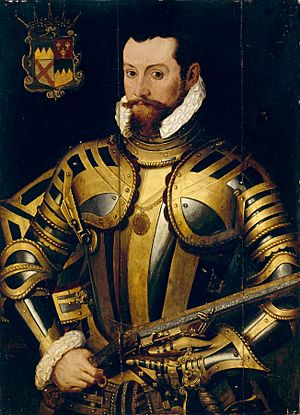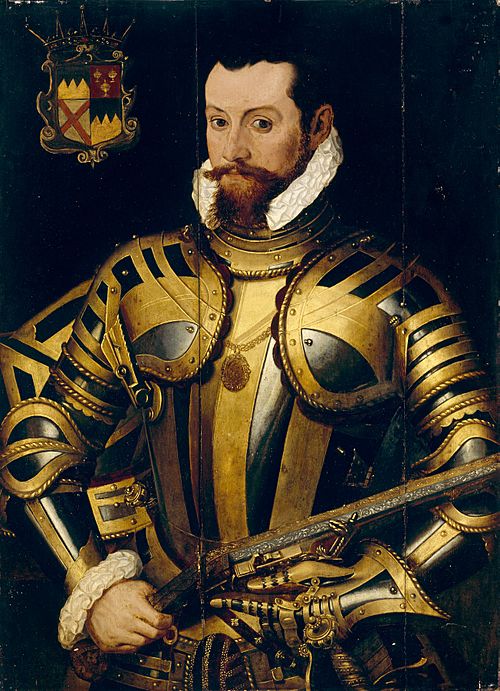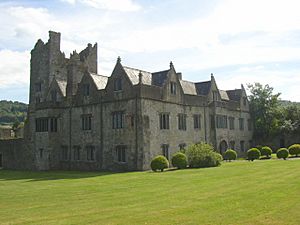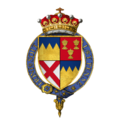Thomas Butler, 10th Earl of Ormond facts for kids
Quick facts for kids
Thomas Butler
|
|
|---|---|
| Earl of Ormond | |
|
A close-up of the portrait below
|
|
| Tenure | 1546–1614 |
| Predecessor | James, 9th Earl of Ormond |
| Successor | Walter, 11th Earl of Ormond |
| Born | February 1531 |
| Died | 22 November 1614 Carrick-on-Suir, Ireland |
| Spouse(s) |
|
| Issue Detail |
Elizabeth, only surviving child |
| Father | James Butler |
| Mother | Joan Fitzgerald |
Thomas Butler, 10th Earl of Ormond (born around 1531 – died 1614), was an important person in the court of Elizabeth I in London. He was also the 3rd Earl of Ossory. From 1559 until he died, he served as the Lord Treasurer of Ireland. This meant he managed the Queen's money in Ireland. He fought in several conflicts for the English crown, including the Rough Wooing, the Desmond Rebellions, and Tyrone's Rebellion. He even fought against his rival, Gerald FitzGerald, 14th Earl of Desmond, in the Battle of Affane in 1565.
Contents
Early Life and Family Roots
Thomas Butler was born in February 1531 in southern Ireland. He was the oldest son of James Butler and Joan FitzGerald. His father became the 9th Earl of Ormond in 1539.
His father's family, the Butler dynasty, were an old English family. They came from Theobald Walter, who was made Chief Butler of Ireland in 1177 by King Henry II.
Thomas's mother was the daughter of James FitzGerald, 10th Earl of Desmond. Her family, the Geraldines, were also an old English family. Thomas's parents married around 1528. Thomas was their first child. He had six younger brothers.
Growing Up in England
In 1539, Thomas's grandfather passed away. His father then became the 9th Earl of Ormond. When Thomas was about 13, in May 1544, he was sent to London. He grew up at the English royal court. There, he learned English ways of speaking, dressing, and behaving. He also became a Protestant.
Friendship with Queen Elizabeth I
Thomas and the future Queen Elizabeth met as children in London. They both had a difficult time at court. Thomas was the son of an Irish Earl, and Elizabeth was seen as the "illegitimate daughter of Henry VIII". They were distant cousins, sharing a great-great-great-grandfather.
Elizabeth often called him her "black husband." This showed how close they were.
Becoming the Earl of Ormond
On October 28, 1546, when Thomas was 15, his father died in London. His father was likely poisoned during a dinner. Thomas Butler then became the 10th Earl of Ormond and the 3rd Earl of Ossory. He was now under the care of the King.
Ormond was made a knight on February 20, 1547. This happened at the crowning of Edward VI. In September 1547, he fought against the Scots at the Battle of Pinkie. This battle was part of the Rough Wooing. In 1554, he helped stop Wyatt's rebellion during Queen Mary's rule.
His mother married again in 1548. Then she married Gerald FitzGerald, 14th Earl of Desmond in 1551.
In 1554, Thomas had a son named Piers. On November 17, 1558, Elizabeth became Queen of England. On August 26, 1559, Queen Elizabeth made Ormond the Lord Treasurer of Ireland. This also made him a special advisor to the Irish government.

First Marriage and Home
Around 1559, Ormond married his first wife, Elizabeth Berkeley. She was known for her beauty at court. However, their marriage was not happy. They separated in 1564 and had no children. Elizabeth refused to get a divorce. She died on September 1, 1582. This meant Ormond had no direct heir. His younger brother Edmund was next in line to inherit his title.
In the 1560s, Ormond built a large new part of Ormonde Castle. This was a Tudor-style manor house. It was located on the River Suir in Carrick-on-Suir, County Tipperary. He built it so Queen Elizabeth would have a grand place to stay if she visited Ireland. Elizabeth planned to visit twice, but she never made it. She died before her last planned visit in 1603. Elizabeth liked Thomas very much. Thomas lived 11 years longer than Elizabeth.
Conflicts in Ireland
The Battle of Affane
Ormond spent much of his life in a strong rivalry with the Earls of Desmond. The Desmonds were neighbors to the Ormonds. Even though they were enemies, both families were Old English and had married each other many times. Ormond's own parents were an example of this. These conflicts were also part of the larger Tudor conquest of Ireland.
In 1560, Ormond's mother helped stop a fight between the two families. But shortly after her death in 1565, the two sides fought the Battle of Affane. This happened on February 8, 1565. Ormond's brother Edmund shot Gerald FitzGerald, 14th Earl of Desmond in the hip. Desmond was then captured by Ormond's group. Both Ormond and Desmond were called to London and told to keep the peace.
That summer, Ormond was very popular with the Queen.
Desmond Rebellions
The first Desmond Rebellion (1569–1573) began when James FitzMaurice FitzGerald started fighting. He was the leader of the Desmond forces. Many Irish people in southern Ireland supported him. Some of Ormond's brothers, like Edmund, also joined the rebellion. This fight was against Henry Sidney, the Queen's representative in Ireland. Ormond returned to Ireland in July 1569. His brothers quickly gave up.
However, Edmund, Edward, and Piers lost their rights and titles in April 1570. This meant Edmund was no longer next in line to be Earl. His next brother, John Butler of Kilcash, took his place. But John died soon after, in May 1570. So, John's oldest son, Walter, became the next in line. The first Desmond rebellion ended in 1573.
The second Desmond Rebellion (1579–1583) started when James FitzMaurice FitzGerald landed in Dingle in June 1579. Lord Desmond then joined the rebellion. Ormond was made governor of Munster and sent to Ireland.
Both rebellions caused a lot of damage in Munster for many years. Ormond was a Protestant and supported Queen Elizabeth I. He used his power to help stop the rebels. He was also motivated by his family's rivalry with the Desmonds. He led the Royal Irish Army and eventually put down the rebellions.
Later Life and Family
At 51, after his first wife died in 1582, Ormond married again. His second wife was Elizabeth Sheffield. They married on November 9 in London.
Thomas and Elizabeth had three children:
- John (1584–1589), who died young.
- Elizabeth (born before 1593 – died 1628). She first married her cousin Theobald. He was the son of Thomas's brother Edmund. Theobald died without children in 1613. Elizabeth then married Richard Preston, 1st Earl of Desmond. They had one daughter, Elizabeth Preston.
- Thomas (born before 1601 – died 1606). He died young on January 17, 1606, and is buried in Carrick-on-Suir.
In 1580, Ormond made improvements to Kilkenny Castle. He built a large gallery there.
In 1588, Queen Elizabeth made Ormond a Knight of the Garter. When the Spanish Armada threatened England that summer, he was with the Queen. He was at the review of the troops at Tilbury. There, she gave her famous patriotic speech. Ormond had the honor of carrying the sword of state in front of her.
In 1600, he helped put down Tyrone's Rebellion. For a few months in 1600, he was captured by Owny MacRory O'More.
Ormond's second wife died in November 1600. In June 1601, Ormond, who was 70 years old, married his third wife. She was Helena Barry. This marriage had no children.
He was also made vice-admiral of Leinster in 1602.
There is a story about the 10th Earl of Ormond when he was old and blind. He was celebrating Christmas at Carrick Castle. He heard a noise and asked who it was. He was told it was little Jemmy of Kilcash, his grand-nephew. The Earl held the boy on his lap. He said that his family would face hard times, but this boy would bring them back to greatness.
In 1613, his son-in-law, Lord Tulleophelim, died without children. The King decided that Ormond's daughter Elizabeth should marry Lord Dingwall.
Death and Legacy
The tenth Lord Ormond died on November 22, 1614, at Carrick. He was buried at St Canice's Cathedral in Kilkenny.
Since the Earl had no sons who could legally inherit his title, and his younger brother Edmund had lost his rights, the Earldom went to another part of the family. It went to the Kilcash branch, which started with his third brother, John Butler of Kilcash. John's son, Walter, became the next Earl.
| Important Dates in Thomas Butler's Life | ||
|---|---|---|
| His exact birth date is not known, so his ages are estimates. | ||
| Age | Date | Event |
| 0 | 1531, Feb, about | Born |
| 8 | 1539, Aug 26 | Father became 9th Earl. |
| 13 | 1544, May | Moved to London. |
| 15 | 1546, Oct 28 | Father died. |
| 15 | 1547, Jan 28 | Edward VI became King. |
| 15 | 1547, Feb 20 | Knighted at Edward VI's crowning. |
| 16 | 1547, Sep 10 | Fought at the Battle of Pinkie. |
| 22 | 1553, Jul 6 | Queen Mary I became Queen. |
| 23 | 1554, Sep 10 | Son Piers was born. |
| 27 | 1558, Nov 17 | Queen Elizabeth I became Queen. |
| 28 | 1559, Aug 26 | Appointed Lord Treasurer of Ireland. |
| 28 | 1559, about | Married his first wife, Elizabeth Sheffield. |
| 33 | 1565, Jan 2 | Mother died. |
| 33 | 1565, Feb 8 | Battle of Affane took place. |
| 38 | 1569 | First Desmond Rebellion began. |
| 39 | 1570, April | His brothers Edmund, Edward, and Piers lost their rights. |
| 48 | 1579 | Second Desmond Rebellion began. |
| 51 | 1582, Sep 1 | First wife died. |
| 51 | 1582, Nov 9 | Married his second wife. |
| 54 | 1585, about | Daughter Elizabeth was born. |
| 57 | 1588, Aug | Carried the sword for Queen Elizabeth at Tilbury. |
| 62 | 1593 | Tyrone's Rebellion began. |
| 69 | 1600, Nov | Second wife died. |
| 70 | 1601, Jun | Married his third wife. |
| 72 | 1603, Mar 24 | King James I became King. |
| 72 | 1603 | Daughter married Theobald. |
| 74 | 1606, Jan 17 | Son Thomas died. |
| 82 | 1613, early | Son-in-law died. |
| 83 | 1614, autumn | Daughter married Richard Preston. |
| 83 | 1614, Nov 22 | Died at Carrick-on-Suir. |
Important Roles He Held
Here are some of the important jobs Thomas Butler had:
- Treasurer of Ireland (1559–1614)
- Lieutenant of County Tipperary (1575)
- Lieutenant of County Kilkenny (1575)
- Lord General of the Forces in Munster (1582–1583)
- General of the Forces in Leinster (1594–1596)
- Lieutenant-General of all Forces in Ireland (1597)
- Vice-Admiral of Leinster (1602)
Images for kids





